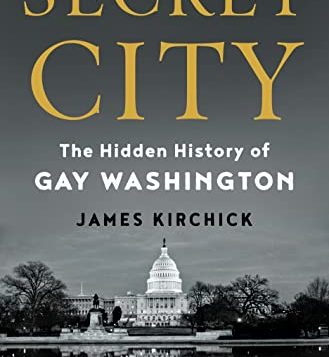IN 1964, one Bob Waldron, a friend and admirer of Lyndon Johnson, was betrayed in the course of a background check on his application to work in the LBJ White House. Waldron was just one of countless gay men in Washington whose ambitions and talents were thwarted, their careers often destroyed, in the decades-long panic about homosexuality that ruled our nation’s capital in the postwar era.
Rescued from near-obscurity by James Kirchick’s sweeping history, Secret City: The Hidden History of Gay Washington, Waldron’s downfall was a footnote, and collateral damage, to the more momentous scandal involving Walter Jenkins, a top aide to Johnson who was arrested for having sex with a man in the basement of a Washington YMCA just weeks before the 1964 election. The casual trashing of Jenkins once the incident came to light seems emblematic of an oppressive atmosphere that weighed on the lives of gay people in Washington for more than half a century.
Secret City flips a light switch on, illuminating over six decades and eleven presidential administrations, from Roosevelt to Clinton. What’s shown is an epic story with a cast of thousands—well-known and forgotten, villains and victims. It’s a history of gay Washington, where the fear of blackmail and the rise of a vast national security apparatus during the Cold War years made being gay especially dangerous. Furthermore, the panoramic scope of Kirchick’s narrative raises this LGBT history to an American story with national significance.
No one will be surprised by how sinister J. Edgar Hoover—almost certainly gay himself—was in his deployment of secrets about people’s private lives to silence or ruin them. But Kirchick offers new insights into the confrontation between Alger Hiss and Whittaker Chambers, and about the Army-McCarthy hearings of the 1950s—both of which episodes were replete with undertones and insinuations of homosexuality.
Kirchick is a good storyteller, and some of the episodes, when they are not tragic or filled with cruelty, are quite entertaining. In 1948, the Lafayette Chicken Hut opened on H Street with a restaurant on the first floor catering to straight people and a piano bar upstairs that hosted a gay clientele. The piano player, Howard (nicknamed Miss Hattie), entertained customers by singing popular ditties retooled with sexualized lyrics. After a particularly ribald line, the crowd would shout “Did you hear that, Miss Blick?”—a reference to Lt. Roy Blick of the District police morals division, for years the scourge of D.C. cruising sites.
In August 1961, the first meeting of the Washington chapter of the Mattachine Society, the original gay rights organization in the U.S., was held at the Hay-Adams Hotel at the northwest corner of Lafayette Square, across from the White House. Convened by chapter founder Frank Kameny, a gifted astronomer fired from the Army Map Service in 1957 for being gay, the meeting was infiltrated by an officer of the police morals division who was so well-known by gay men in the city that when Kameny called him out, the officer scurried out of the room.
As Kirchick moves into the 1970s, when gay people began to assert themselves after the Stonewall Riots, he details the opening of Lambda Rising, the city’s gay bookstore (now defunct); the first issues of The Blade, the city’s gay weekly newspaper, originally edited by Nancy Tucker; and the advent of openly gay bars and discos. The special grubbiness of the Reagan era is recalled in Kirchick’s account of the anti-Communist gay conservatives on the fringes of the Reagan Administration who were at the heart of the money, gun-running, and grifting that became known as Iran-Contra.
For a work so focused on politics and politicians, Secret City is not a polemic, even though support for gay rights has for many decades been skewed toward Democratic politics. This resulted in some weird dissonances on the part of openly gay conservatives, and charges of hypocrisy for those still in the closet. Kirchick spares no scorn for the latter (as for the Reagan administration’s lethal negligence of the AIDS epidemic), which he casts as a feature of the decades-long shadow under which even liberal people and publications like The Washington Post had to operate.
If there’s a hero in the book, it would be Frank Kameny, founder of the D.C. Mattachine and the activist most responsible for the repeal of the prohibition on gay people holding civil service jobs. From the very beginning, Kameny dismissed the idea that he had a “problem” (whether a mental illness or a criminal bent) for which he needed to apologize, and he spent his life working for a cause that was initially regarded as foolish and hopeless. On the day in 1975 when the ban was repealed, Kameny called it the government’s “surrender document.” Because of Kameny and countless others like him, the secret city Kirchick describes no longer exists.
Several years ago, a gentleman approaching his sixties found himself at D.C.’s National’s Park for a baseball game. He had been born in the D.C. area, lived in the city through many of the years chronicled in Secret City, and was recently returned. Like so many of the men and women in Kirchick’s story, he had spent too much of his life hiding from himself. Strolling the stands between innings, he happened to pass two young men in their early thirties, placidly walking through the sunlit crowd holding hands. He watched as they walked, marveling that so far as he could see no one anywhere was batting the proverbial eyelash. That night, the elder man, this reviewer, went home and recorded the sight in his diary adding, “When did this happen?” Secret City is a chronicle of when and how it happened and who made it happen, a tale told in a hundred human stories of how, after decades of darkness, the lights came on.
Mark Moran, a writer based in Washington, D.C., writes about medicine, science, health, and mental health.







